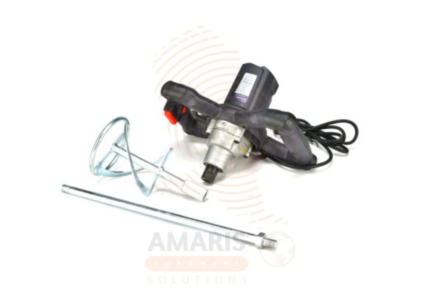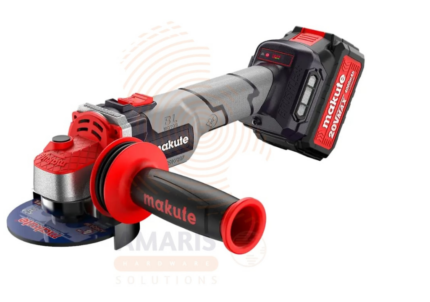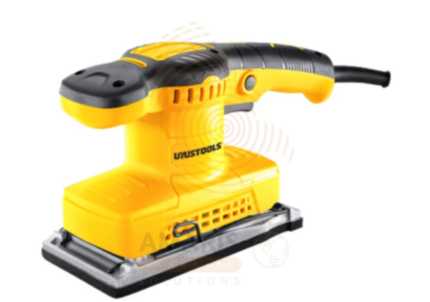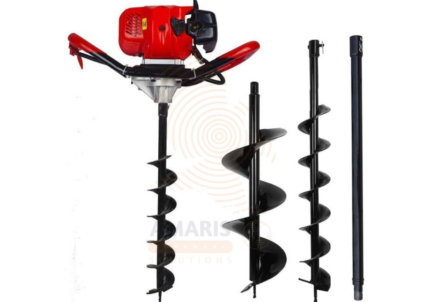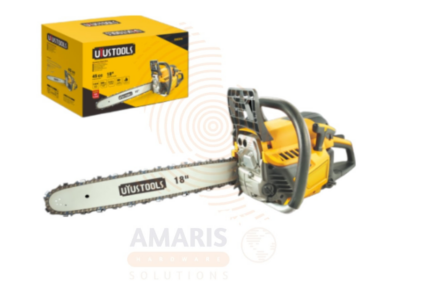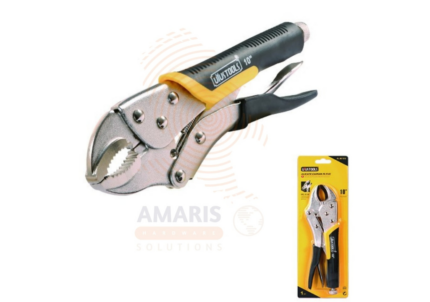
Curved Jaws Locking Pliers - TPR Handle
$17.42 Original price was: $17.42.$16.55Current price is: $16.55.
Cut Off Saw
$111.54 Original price was: $111.54.$105.96Current price is: $105.96.
WhatsApp Order
A Cut Off Saw, also known as a cut-off saw or chop saw, is a power tool designed for cutting through various materials, typically metals, plastics, or wood, by utilizing a rotating abrasive or toothed disc. It is commonly used in construction, metalworking, and woodworking applications to make precise and controlled cuts at specific angles or lengths. The saw typically features a sturdy base or table to support the material being cut, and its design allows for efficient and accurate cutting in a straight line or at predetermined angles.
Description
Table of Contents
ToggleCut Off Saw
Uses
-
Metal Cutting:
-
Cutoff saws are extensively used in metalworking industries to cut through different types of metals, such as steel, aluminum, and copper.
-
They are employed for tasks like cutting pipes, rods, bars, and other metal profiles to specific lengths.
-
-
Construction and Demolition:
-
In construction and demolition work, cutoff saws are used to make precise cuts in materials like concrete, asphalt, and masonry.
-
They are commonly utilized for creating openings in walls, cutting expansion joints, or removing damaged sections of concrete.
-
-
Woodworking:
-
Cutoff saws can be used in woodworking to make accurate and clean cuts in wooden materials, such as lumber or plywood.
-
They are helpful in tasks like framing, molding, or creating custom lengths of wood for various construction projects.
-
-
Tile Cutting:
-
In the field of tile installation, cutoff saws equipped with diamond blades are employed to cut through ceramic, porcelain, or stone tiles.
-
This ensures precise and clean cuts, especially when dealing with intricate tile patterns or custom shapes.
-
-
Metal Fabrication:
-
Cutoff saws play a crucial role in metal fabrication processes, assisting in the production of metal components, brackets, and structures.
-
They are often used to cut metal tubing, angle iron, and other metal shapes to the desired dimensions.
-
-
Automotive Repair:
-
-
In automotive repair and fabrication, cutoff saws are used to cut through metal parts like exhaust pipes, tubing, or frame components.
-
They are valuable tools for making precise cuts in automotive materials during repair or customization projects.
-
-
Plumbing and Electrical Work:
-
-
Cutoff saws are utilized in plumbing and electrical installations to cut through pipes, conduit, and other materials.
-
They assist in creating accurate lengths for various components used in plumbing and electrical systems.
-
-
Home Improvement:
-
-
DIY enthusiasts and homeowners often use cutoff saws for various home improvement projects, including cutting lumber, PVC pipes, or metal components.
-
-
Landscaping:
-
-
In landscaping applications, cutoff saws may be used to cut through landscape edging, concrete pavers, or other materials to create well-defined paths or features.
-
-
Emergency Response:
-
-
In emergency situations, cutoff saws can be used by rescue teams to quickly cut through debris or structures to reach and assist individuals in need.
-
SAFETY HANDLING PRECAUTIONS
Safety Precautions
-
Personal Protective Equipment (PPE):
-
Wear appropriate PPE, including safety glasses or goggles to protect your eyes from debris, hearing protection due to the loud noise generated, a dust mask if cutting materials produce dust, and gloves to protect your hands.
-
-
Clothing:
-
Avoid loose clothing, jewelry, and tie back long hair to prevent them from getting caught in the saw.
-
-
Footwear:
-
Wear sturdy and slip-resistant footwear to provide proper support and reduce the risk of slipping.
-
-
Secure Work Area:
-
Ensure that the work area is clean, well-lit, and free of obstacles. Keep bystanders at a safe distance to avoid potential injuries.
-
-
Stable Surface:
-
Place the cutoff saw on a stable and level surface to prevent it from tipping over during operation.
-
-
Secure the Material:
-
Secure the material to be cut firmly in place using clamps or other appropriate fixtures. This helps prevent the material from shifting during cutting.
-
-
Check Blades:
-
Ensure that the cutting blade is in good condition, sharp, and properly mounted. Follow the manufacturer's guidelines for blade installation and replacement.
-
-
Adjust the Depth:
-
Adjust the cutting depth of the saw to match the thickness of the material being cut. This prevents excessive blade exposure, reducing the risk of kickback.
-
-
Start Safely:
-
Start the cutoff saw away from the material being cut to allow the blade to reach full speed before making contact with the workpiece.
-
-
Two-Handed Operation:
-
Whenever possible, use both hands to operate the cutoff saw. This provides better control and stability.
-
-
Avoid Overreaching:
-
Maintain a stable stance and avoid overreaching while operating the saw. Reposition the material or yourself to ensure proper balance.
-
-
Wait for the Blade to Stop:
-
Allow the cutoff saw blade to come to a complete stop before setting it down or moving it. Do not leave the saw unattended while the blade is still spinning.
-
-
Disconnect Power:
-
Disconnect the power source before changing blades or making adjustments to the cutoff saw.
-
-
Follow Manufacturer's Guidelines:
-
Always adhere to the manufacturer's safety instructions and guidelines provided in the user manual.
-
-
Training and Supervision:
-
Ensure that operators are properly trained in the use of the cutoff saw. Supervise less experienced users until they are familiar with safe operating procedures.
-
Related products
Bi-Metal Hole Saw Set
A 9 PCS Bi-Metal Hole Saw Set refers to a collection of nine hole saws, each constructed with a bi-metal design. A hole saw is a cylindrical cutting tool used to create holes in various materials such as wood, metal, plastic, and more. The term "bi-metal" indicates that the hole saws are made from two different types of metals, typically high-speed steel (HSS) and a more durable alloy like cobalt. This combination enhances the hole saw's cutting performance, making it suitable for a wide range of applications and providing increased durability and longevity. The set typically includes hole saws of different sizes to accommodate various hole diameters, making it a versatile tool for professionals and DIY enthusiasts alike.
Cement And Paint Mixer
A cement and paint mixer is a mechanical device designed to efficiently and homogeneously blend cement or paint constituents to achieve a uniform and consistent mixture. Typically utilized in construction and painting applications, these mixers come in various designs, including portable or stationary models. They feature rotating blades, paddles, or agitators that facilitate the thorough mixing of dry or liquid materials, ensuring the creation of a well-mixed and homogeneous product suitable for construction or painting purposes.
Circular Saw Blade for Wood
A circular saw blade for wood is a cutting tool designed specifically for use with a circular saw. It typically consists of a flat, circular disc with sharp teeth along its outer edge. The blade is mounted onto the arbor of the circular saw, and as the saw operates, the blade spins rapidly to cut through wood materials. Circular saw blades for wood are specifically engineered to make efficient and clean cuts in wood, and they come in various sizes and tooth configurations to suit different cutting tasks and wood types. The teeth on the blade are strategically shaped and arranged to ensure smooth and precise cutting while minimizing splintering and tear-out on the wood surface.
Cordless Angle Grinder
A cordless angle grinder is a handheld power tool designed for cutting, grinding, and polishing materials, typically metal or masonry. Unlike traditional angle grinders that are powered by electrical cords, cordless angle grinders are equipped with rechargeable batteries, providing greater mobility and flexibility in various work environments. These tools often feature a rotating disc or wheel that can be fitted with different abrasive attachments, allowing users to perform a variety of tasks such as cutting metal, smoothing welds, or removing rust and paint. Cordless angle grinders are widely used in construction, metalworking, and fabrication applications.
Finishing Sander
The finishing sander is a high-performance power tool designed to deliver smooth, even surfaces on wood, metal, or painted materials. Its ergonomic design allows for comfortable handling during extended use, while its powerful motor ensures consistent sanding performance. Perfect for removing minor imperfections, preparing surfaces for paint or varnish, and achieving a professional-quality finish, this tool is ideal for carpenters, woodworkers, DIY enthusiasts, and home improvement projects. The finishing sander is compatible with a variety of sanding pads and accessories, making it versatile for different applications and finishing requirements.
Forstner Bits
PRODUCT DESCRIPTION
A Forstner bit is a specialized woodworking drill bit designed for creating flat-bottomed holes with a clean and precise finish. Unlike traditional twist drill bits, Forstner bits have a cylindrical, flat-bottomed shape with a center point and cutting edges along the circumference. These bits are commonly used when a smooth and accurately sized hole without breakthrough is required in woodworking applications, such as for drilling holes for dowels or creating recesses for hardware like hinges. Forstner bits are known for their ability to produce clean and splinter-free boreholes, making them popular among woodworkers and cabinetmakers for tasks that demand precision and aesthetics.
Gasoline Auger Machine
A gasoline auger machine is a power tool designed for drilling holes in the ground using a rotating helical screw blade, commonly known as an auger. Unlike electric or manual augers, a gasoline auger machine is powered by a gasoline engine, providing greater mobility and independence from electrical power sources. This type of machine is commonly used in construction, landscaping, and agriculture for tasks such as digging holes for fence posts, planting trees, or installing various types of foundations. The gasoline engine provides the necessary power to turn the auger bit efficiently, making it suitable for heavy-duty and remote applications where access to electricity may be limited.
Gasoline Chain Saw
A Gasoline Chain Saw is a portable, mechanical cutting tool powered by an internal combustion engine that runs on gasoline. It typically consists of a chain with teeth attached to a guide bar, driven by the engine, and is commonly used for tasks such as tree felling, limb pruning, and wood cutting. The gasoline engine provides the necessary power to drive the chain, making the chainsaw a versatile tool for various outdoor cutting applications.


 Acrylic Sealants
Acrylic Sealants Construction Adhesives
Construction Adhesives Double-Sided Tape
Double-Sided Tape Duct Tape
Duct Tape Electrical Tape
Electrical Tape Epoxy & Resins
Epoxy & Resins Masking Tape
Masking Tape
 Automotive Wrenches & Socket Sets
Automotive Wrenches & Socket Sets Battery Chargers & Jump Starters
Battery Chargers & Jump Starters Car Jacks & Stands
Car Jacks & Stands Car Wash & Detailing Products
Car Wash & Detailing Products Diagnostic Tools
Diagnostic Tools Tire Inflators
Tire Inflators Vehicle Lighting
Vehicle Lighting Oil & Lubricants
Oil & Lubricants
 Adhesives & Sealants
Adhesives & Sealants Bricks & Blocks
Bricks & Blocks Cement & Concrete
Cement & Concrete Drywall & Plaster
Drywall & Plaster Flooring (Tiles, Wood, Laminate)
Flooring (Tiles, Wood, Laminate) Lumber & Plywood
Lumber & Plywood Paints, Primers & Coatings
Paints, Primers & Coatings Insulation Materials
Insulation Materials Roofing Materials
Roofing Materials
 Circuit Breakers
Circuit Breakers Electrical Cables & Wires
Electrical Cables & Wires Switches & Sockets
Switches & Sockets Fuses & Relays
Fuses & Relays Connectors & Terminals
Connectors & Terminals Electrical Boxes & Panels
Electrical Boxes & Panels Conduit & Fittings
Conduit & Fittings Lighting Fixtures & Bulbs
Lighting Fixtures & Bulbs Extension Cords & Power Strips
Extension Cords & Power Strips
 Anchors
Anchors Bolts
Bolts Clips & Clamps
Clips & Clamps Screws
Screws Nuts
Nuts Washers
Washers Rivets
Rivets Nails
Nails Threaded Rods
Threaded Rods
 Hammers
Hammers Measuring Tools (Tapes, Levels, Calipers)
Measuring Tools (Tapes, Levels, Calipers) Screwdrivers
Screwdrivers Pliers & Cutters
Pliers & Cutters Saws & Blades
Saws & Blades Chisels & Punches
Chisels & Punches Allen Keys & Hex Keys
Allen Keys & Hex Keys Ratchets & Socket Sets
Ratchets & Socket Sets Wrenches & Spanners
Wrenches & Spanners
 Power Tool Accessories (Blades, Bits, Discs)
Power Tool Accessories (Blades, Bits, Discs) Rotary Tools
Rotary Tools Saws (Circular, Jigsaw, Reciprocating)
Saws (Circular, Jigsaw, Reciprocating) Drills & Drivers
Drills & Drivers Grinders & Sanders
Grinders & Sanders Heat Guns
Heat Guns Nail Guns
Nail Guns Impact Wrenches
Impact Wrenches Batteries & Chargers
Batteries & Chargers
 Pipes & Fittings (PVC, Copper, PEX)
Pipes & Fittings (PVC, Copper, PEX) Plumbing Tools
Plumbing Tools Pumps & Motors
Pumps & Motors Sealants & Adhesives for Plumbing
Sealants & Adhesives for Plumbing Valves & Taps
Valves & Taps Water Heaters
Water Heaters Drainage Systems
Drainage Systems Faucets & Fixtures
Faucets & Fixtures Hoses & Tubing
Hoses & Tubing
 Hinges & Latches
Hinges & Latches Hooks & Brackets
Hooks & Brackets Window Hardware
Window Hardware Chains & Cables
Chains & Cables Casters & Wheels
Casters & Wheels Shelving & Storage Systems
Shelving & Storage Systems Door Handles & Locks
Door Handles & Locks Drawer Slides & Cabinet Hardware
Drawer Slides & Cabinet Hardware
 Personal Protective Equipment (PPE)
Personal Protective Equipment (PPE) Respirators & Masks
Respirators & Masks Safety Glasses
Safety Glasses Safes
Safes Security Cameras
Security Cameras Gloves
Gloves Helmets
Helmets Ear Protection
Ear Protection Fire Safety Equipment
Fire Safety Equipment Locks & Padlocks
Locks & Padlocks Motion Sensors & Alarms
Motion Sensors & Alarms
 Garden Fencing
Garden Fencing Garden Furniture Hardware
Garden Furniture Hardware Lawn Mowers
Lawn Mowers Trimmers & Edgers
Trimmers & Edgers Shovels & Spades
Shovels & Spades Rakes & Hoes
Rakes & Hoes Pruning Shears & Loppers
Pruning Shears & Loppers Watering Systems (Hoses, Sprinklers, Nozzles)
Watering Systems (Hoses, Sprinklers, Nozzles)
 Interior Paints
Interior Paints Paint Brushes & Rollers
Paint Brushes & Rollers Paint Strippers & Thinners
Paint Strippers & Thinners Paint Trays & Accessories
Paint Trays & Accessories Exterior Paints
Exterior Paints Spray Paints
Spray Paints Primers & Undercoats
Primers & Undercoats Varnishes & Stains
Varnishes & Stains
 Gaskets & Seals
Gaskets & Seals Hydraulic Fittings
Hydraulic Fittings Industrial Fasteners
Industrial Fasteners Industrial Hoses
Industrial Hoses Lubricants & Greases
Lubricants & Greases Metal Sheets & Bars
Metal Sheets & Bars Bearings & Bushings
Bearings & Bushings Belts & Pulleys
Belts & Pulleys
 HVAC Filters
HVAC Filters Insulation for HVAC
Insulation for HVAC Air Conditioners
Air Conditioners Refrigerants
Refrigerants Ventilation Ducts & Fittings
Ventilation Ducts & Fittings Thermostats & Controllers
Thermostats & Controllers Fans & Blowers
Fans & Blowers
 Pegboards & Hooks
Pegboards & Hooks Shelving Units
Shelving Units Storage Bins & Containers
Storage Bins & Containers Toolboxes & Tool Chests
Toolboxes & Tool Chests Workbenches
Workbenches Drawer Organizers
Drawer Organizers Labeling Supplies
Labeling Supplies
 Welding Accessories (Clamps, Brushes)
Welding Accessories (Clamps, Brushes) Welding Electrodes & Rods
Welding Electrodes & Rods Welding Helmets & Gloves
Welding Helmets & Gloves Welding Machines
Welding Machines Soldering Irons & Stations
Soldering Irons & Stations Flux & Solder Wire
Flux & Solder Wire
 Generator Accessories
Generator Accessories Inverters
Inverters Portable Generators
Portable Generators Power Inverters
Power Inverters Transfer Switches
Transfer Switches Diesel & Gasoline Generators
Diesel & Gasoline Generators
 Transport Equipment: Carts, Dollies, and Hand Trucks
Transport Equipment: Carts, Dollies, and Hand Trucks Storage Solutions: Pallets, Racks, and Containers
Storage Solutions: Pallets, Racks, and Containers Lifting Equipment: Hoists, Cranes, and Jacks
Lifting Equipment: Hoists, Cranes, and Jacks Conveyors and Accessories: Belts and Rollers
Conveyors and Accessories: Belts and Rollers

